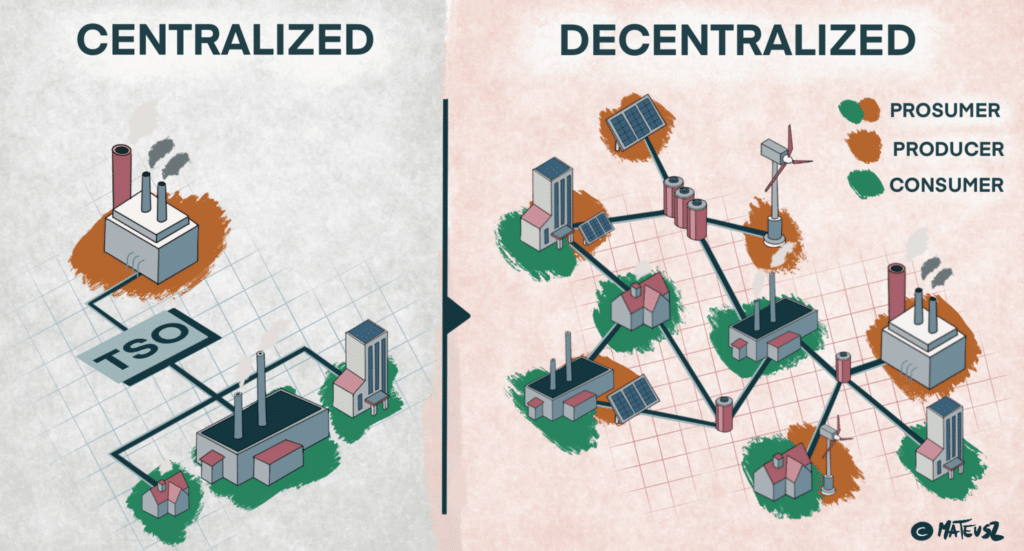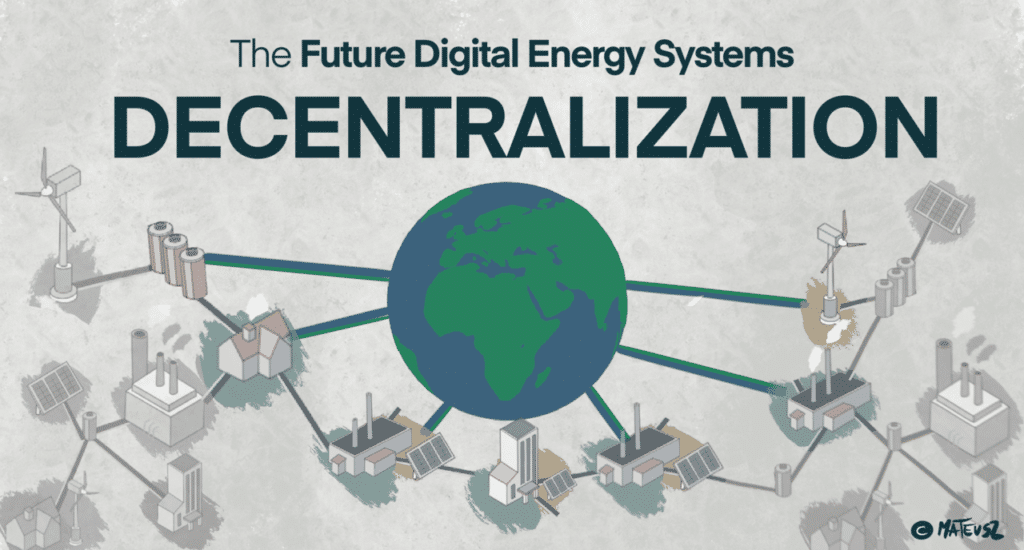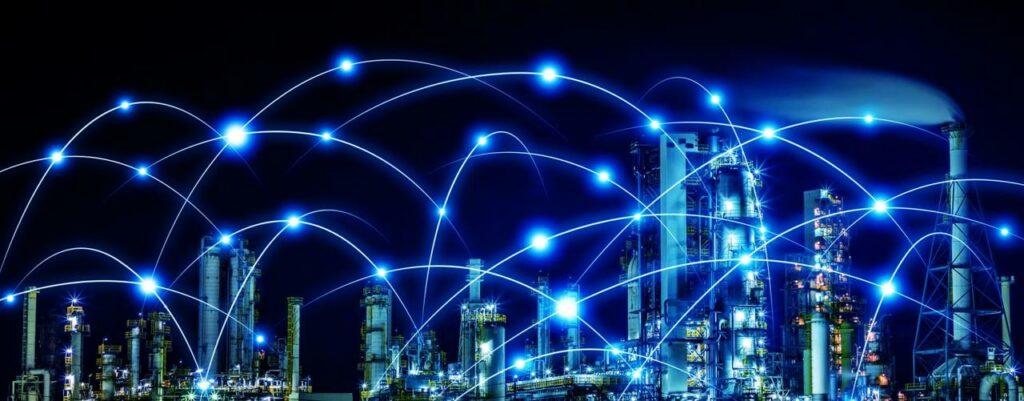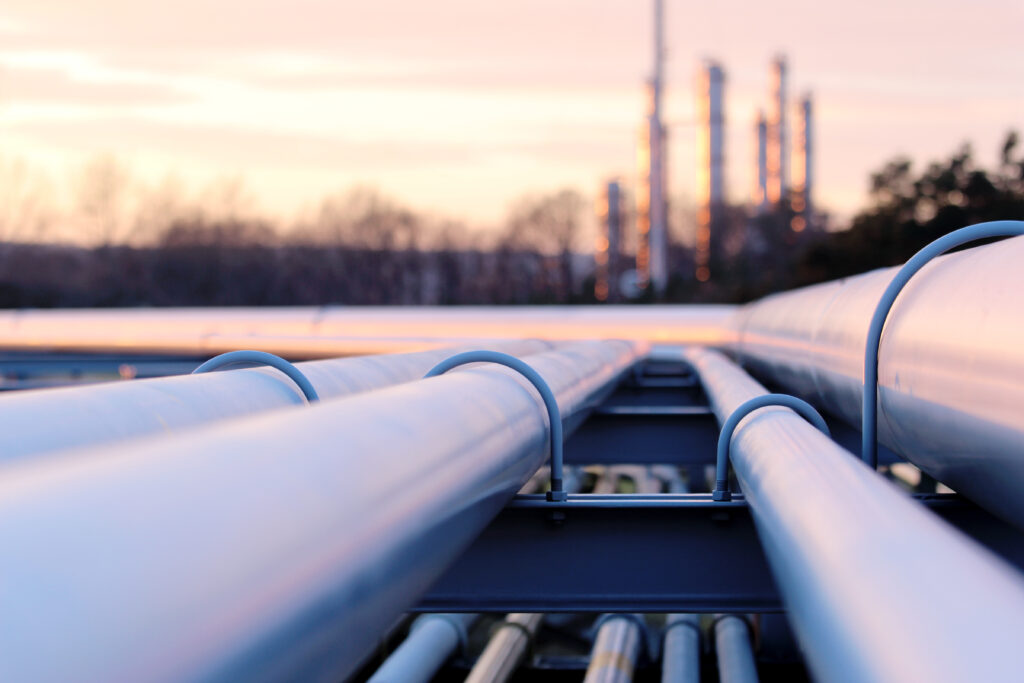When asked to describe The Future Digital Energy System in only two words, I instantly say decarbonized and decentralised.
Decarbonisation perfectly expresses the physical aspects of energy systems of tomorrow, which rely on a selection of technologies that minimize any excess carbon atoms emitted into the atmosphere.
Decentralization, on the other hand, is an excellent synopsis of all transitions that need to happen at the information technology and communication levels. Having a factual energy transition without decarbonization and decentralization as a center of gravity for next-gen energy systems is implausible.
In my previous article, I outlined possible decarbonization scenarios. Now, it is time to look at The Future Digital Energy Systems from the perspective that all green technologies can interconnect and cooperate to provide a robust, secure, and optimized low-carbon system.
(De-)centralized Energy Systems
First, let me briefly explain the differences between what we have today and our target setup. Nowadays, energy systems are concentrated on a stable, centralized energy supply, delivered mainly by power plants. Centralized energy systems are always working the balance between the demand and supply side, which is managed by TSOs (Transmission System Operators). Energy security is provided by proper monitoring and maintenance of the network, overcapacity of the supply side, and interconnections with other countries. Such networks have a clear split of responsibility between supply, demand, and the grid (TSOs) side.
Once we start decentralizing our energy systems and stem a significant number of consumers and energy sources, a key factor in the stable growth of the network will be the cooperation and interoperability of millions of assets (renewables, batteries, EVs, etc.).

Different energy sources provide an additional degree of freedom and bring an extra dimension to The Future Digital Energy Systems. As explained in my previous article about decarbonization, there are many options for reducing CO2 emissions, from stable and flexible fossil fuel plants (or, of course, with the utilization of CCUS) or nuclear and biomass to more intermittent and scattered wind and solar. The robustness of a decentralized energy system to integrate and utilize the maximum number of different energy sources will be another aspect of the next-gen setup.

Nowadays, rebuilding electrical systems, designed almost 120 years ago, to systems that fulfill new expectations is, together with decarbonization, the most significant part of the Energy Transition. To summarise, next-gen, decentralized energy systems should fulfill various criteria:
- based on low/no carbon sources
- be resilient
- be efficient
- provide transparency
- be reliable
- be stabile
- be affordable
How can we ensure that all required features are covered appropriately? Low-carbon energy will be based on distinct technologies collected under the decarbonization umbrella. Still, to cover the rest of the criteria, we need extensive and structured system decentralization. This effort needs to be modeled around three components: smart grid (network), energy storage (capacity), and services (i.e., demand-side response, blockchain, and virtual power plants).
The Smart Grid
Grid is a well-settled part of current energy systems. Still, it needs a pivotal redesign to ensure proper scaling (also downsizing), decentralization (of ownership, responsibility, and security), and bi-directionality. The design of the smart grid needs to be based on a layered structure (physical assets, energy management, and consumer decisions) to maintain operation and communication with sundry disturbances from both the supply and demand sides.
We require microgrids to uphold a reasonable level of diversification among participants working in one decentralized smart grid. Microgrids are decentralized energy sources and loads that are attached to the grid in normal conditions but can also function autonomously and disconnected from the network. In this way, microgrids significantly improve the security of supply within their operations area and can supply emergency power by switching between autonomous and connected modes.

Each microgrid has its controller, which ensures stability, smooth network operations, and communication with supervisory systems (which take care of the same task but on a macro level).
A particular type of microgrid is off-grid. This type of electrical system always works in island mode. By utilizing the same technologies that warrant resilient, efficient, secure, and reliable microgrids, it is possible to have efficient and stable operations in regions where connection to any type of grid is not possible or financially acceptable. Offgrids can be one of the enablers for scaling up green hydrogen generation on offshore platforms.
A striking analysis of different microgrid opportunities along with benefit studies of its implementation was performed by Metabolic and sponsored by the Dutch government called “The New Strategies for Smart Integrated Decentralized Energy Systems.” A full copy of the final report can be downloaded here. The report provides nine scenarios for four different communities and a holistic evaluation based on payback time, capital investment, self-consumption, and energy production.
Energy Storage
Energy storage is a crucial technology to ensure energy systems’ appropriate flexibility and security. Flexibility mainly reflects the ability to address short-run and unexpected imbalances between demand and supply. Both flexibility and security must be addressed on microgrid, grid, national, or international levels. Distinct gradation means various strategies for choosing the appropriate technology for energy storage. Generally, we can divide energy storage into four categories:
- Electrochemical—mainly different types of batteries (lithium-ion, flow, molten salt, etc.).
- This type of storage has great potential due to its flexibility and scalability. It is the default choice of energy storage at a consumer level (EVs, households, microgrids).
- Physical – -energy storage based on kinetic, potential, or thermal energy (pumped-storage hydroelectricity, compressed air energy storage (CAES), flywheel, thermal energy storage (TES))
- Physical batteries are perfect for storing vast amounts of energy but are constrained by localization or available space. This storage type is capital intensive, so it coheres with macro-scale networks.
- Electromagnetic – mainly supercapacitors and superconducting magnetic energy storage (SMES)
- If I should use one word to describe this storage, it would be superfast. Power density (speed of charge/discharge) is 1000x higher than batteries. Contradictorily, electromagnetic storage can store less energy at the same size as batteries and is prone to self-discharge (even 10-20 percent per day). Supercapacitors are a perfect fit for network stabilization. Still, they can flourish in everyday usage, i.e., EVs (charging a car will be shorter than fueling it up with petrol) or electronic tools (re-charging the tool will take seconds).
- Fuel cells are not typical energy storage but a tool for recovering energy stored in various fuels (e.g., hydrogen and ammonia). Energy retained in molecules can be efficiently transported over longer distances, which can support long-distance transport but also outsource energy generation to more efficient places (e.g., sunnier or windier). Additionally, green hydrogen can be used as backup energy storage in refineries or chemical sites, where it is also utilized as a feedstock.

Services
The available services’ suite strongly depends on infrastructure, as shown in two previous paragraphs of this article: network and capacity. The portfolio of services will change over time and, indeed, will become the torch-bearer of new developments and ideas. Today, we can proffer specific tools that have already established a pretty rigid position on the market and have the potential to swell even further:
- Blockchain is a default choice for ensuring cooperation, transparency, and security between different market participants. Thanks to its vast expandability and well-established position in other sectors (i.e., financial), it is also certain that this service will be our new way of exchanging information.
- Virtual Power Plants allow us to apply known control strategies to scattered assets (virtually centralize control of decentralized sources). With the exponential increase of prosumers, this will be a life-saving service to keep The Future Digital Energy Systems running efficiently, especially in the transition period.
- Demand-side response seems to be my hand-picked service for the midterm horizon. Enabling an increase in collaboration and incentivisation of all participants in the energy system allows us to scale more minor successes to expected benefits. The demand-side response is an exceptional service with different use cases for other system participants. It has been available on the market for some time but has not been utilized to its full potential as grid, and energy storage has not matured enough.
Demand Side Response
Demand Side Response (DSR) is one of the services with the biggest potential to increase the adaptability of electricity demand to a volatile electricity supply. Incentivizing flexibility on the demand side can help stabilize all intermittent energy sources. Hitherto, the main focus was on the management of the supply side. Still, with the expansion of smart grid and smart metering (thus, real-time monitoring and instant communication between market participants), urgency is shifting towards management of the demand side. Prosumers with a dilution of a split between supply and demand provide additional freedom, which can be utilized to optimize and secure Future Digital Energy Systems.
Each household, with a relatively small demand for energy, can participate in the DSR market through aggregators, which combine small-volume users to offer appropriate flexibility. The situation is different with large energy consumers (mainly industry). We can derive different scenarios for different sectors by looking at demand side response from a production process perspective.¹ ²
- Refining & Chemicals – as a large energy consumer, has quite an enormous potential for DSR service, but due to continuous process, activation of service needs to be incremental by shedding production or, if possible, shifting batch production
- Steel & Metal – another energy-intensive segment, where activation of the service is binary (on/off), but due to the thermal inertia of the process, it has to last for at least a week
- Paper – this industry is very keen on DSR as it can provide two types of flexibilities: short-term (1-24 hours) by shifting the whole production batch or long-term (for weeks) by incremental shedding production
- Food – an industry with a considerable volume of sites that, in most cases, are flexible in shedding production or lowering the load on continuous process
- Automotive & Machinery – best example of a district industry where Demand Side Response can be provided with load shifting by using variation in the cycle time of production line machines
The different types of Demand Side Response services are also worth mentioning, and they are divided into internal and external categories. Internal DSR is governed by the asset owners, mainly by apt price stimulus. These are Real-time Pricing (RTP), Time of User (ToU), or Critical Peak Pricing (CPP).
External DSR is superintended by the grid, which can appeal to decrease energy demand, maintain grid parameters, or fulfill market requirements. Typical applications are Direct Load Control, Demand Bidding, Emergency Demand Response, or Ancillary Services.
Conclusion
Yet, some boundaries are impossible to cross – no matter how we decentralize and decarbonize our system, we always have to fit with certain principles. Let’s take vital parameters of the electrical network – voltage and frequency. With electrification and the decreasing relevance of rotating equipment (which is nowadays a major source to manipulate voltage and frequency parameters), we need to appoint new countermeasures (i.e., energy storage or demand side response) to maintain the security and stability of the grid. With the progressing transition towards net-zero, we will see a proportional growth in the complexity of the energy systems which need to serve the constantly increasing number of prosumers and the diversity of the patterns of energy supply and demand.

The positive thing is that this will not happen within a day. We can gradually adapt to upcoming disruptions with new technologies and services. Nevertheless, such a situation sets a new paradigm for our times – stability has become a luxury. We must learn to adapt quickly, become open to changes, and be ardent of upcoming possibilities. Only with such an attitude can we withstand the upcoming energy revolution.
With The Future Digital Energy Systems articles series, I’d like to address the main drivers and enablers of our future energy landscape. Analyzing available technology and required changes in organizations, legislation, and society, I want to disenchant and simplify all actions needed to fulfill net-zero commitments and limit global warming.




